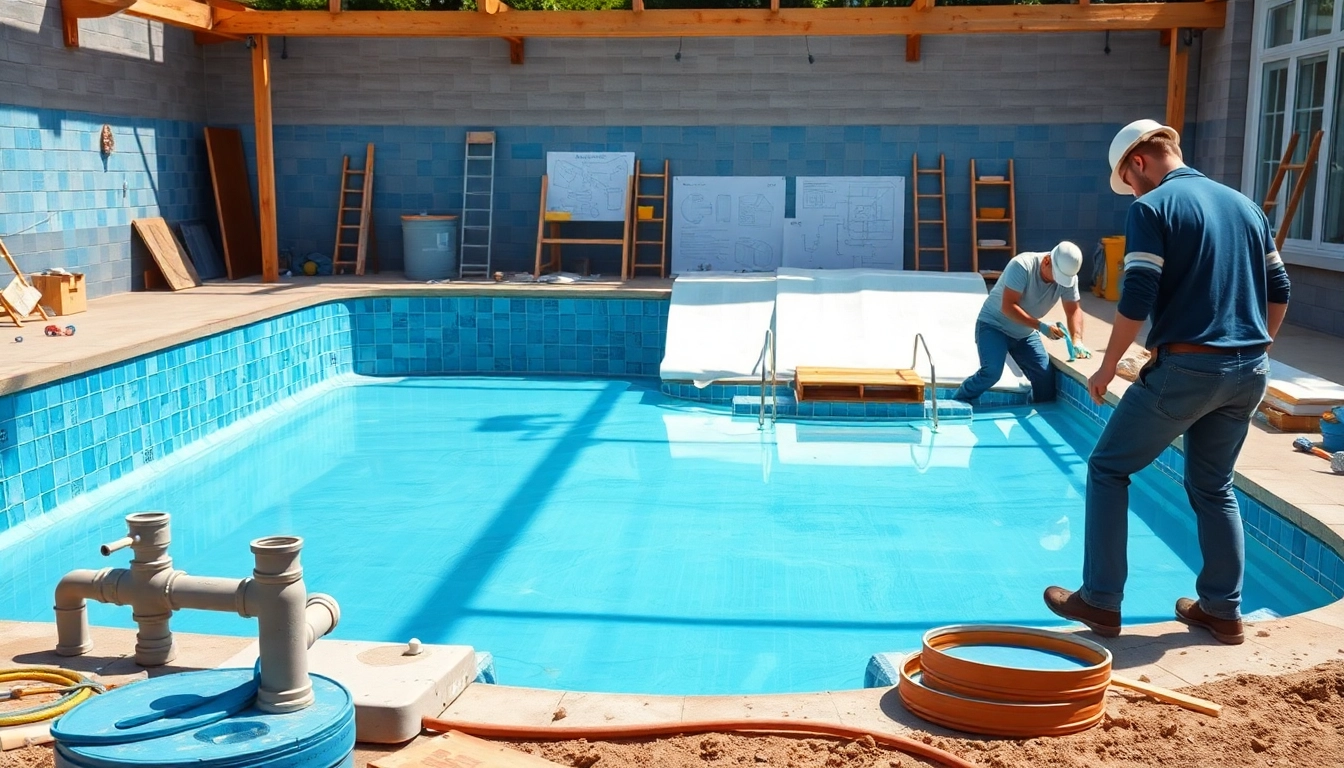
A Comprehensive Guide to Efficient Pool Construction: Steps and Best Practices
Understanding the Basics of Pool Construction
What is Pool Construction?
Pool construction involves the systematic process of creating a swimming pool, which includes planning, designing, and building the structure that will hold water. This process encompasses multiple stages, from initial concept discussions to final inspection and maintenance planning. Each step requires careful attention to detail and extensive knowledge of construction practices, materials, and safety standards.
At its core, pool construction integrates architectural design principles, engineering disciplines, and landscaping aesthetics. Whether it’s a simple family pool or a luxurious resort-style feature with waterfalls and lighting effects, the principles of pool construction remain the same.
Types of Pools: Inground vs. Above Ground
The first step in any pool construction project is deciding on the type of pool that best suits your needs and budget. Generally, pools can be categorized into two main types: inground and above ground.
- Inground Pools: These are permanently constructed below the ground, typically made from concrete, fiberglass, or vinyl. They offer high durability, customization options, and can add significant value to the property.
- Above Ground Pools: Easier to install and usually less expensive, above ground pools are typically made from vinyl liners and aluminum or steel walls. They can be dismantled at any time, making them more flexible for seasonal users.
Regardless of the type, both inground and above ground pools require careful planning and execution to ensure safety, aesthetics, and functionality.
Benefits of Professional Pool Construction
Hiring a professional for pool construction brings numerous benefits. Professional builders are equipped with the knowledge, experience, and resources necessary to execute the project efficiently and effectively. Here are some key advantages:
- Expertise: Professionals understand the ins and outs of pool construction, including local regulations, safety standards, and best practices.
- Quality Assurance: Licensed contractors use high-quality materials and adhere to industry standards, which enhances durability and longevity.
- Time Efficiency: Experienced builders know how to manage timelines and workforce, minimizing delays and ensuring timely completion.
- Design Customization: Professionals can help translate your vision into reality, offering design ideas that you might not have considered.
Planning Your Pool Construction Project
Setting a Budget for Pool Construction
One of the most critical steps in planning your pool construction is establishing a budget. A well-defined budget helps manage expectations and prevents overspending. Factors that will impact your budget include:
- Pool Type: As mentioned, inground pools generally cost more than above ground pools, primarily due to the labor-intensive excavation process involved.
- Size and Depth: Larger and deeper pools require more materials, more extensive excavation, and a higher investment in pumps and filters.
- Materials: The choice of materials (concrete vs. vinyl vs. fiberglass) will directly influence costs.
- Landscaping and Additional Features: Elements like patios, waterfalls, lighting, and pool heating systems can inflate costs considerably.
It’s wise to add a contingency fund of about 10-15% of the total budget to account for unexpected expenses.
Choosing the Right Design and Size
Your choice of pool design and size will significantly influence both the cost and functionality of your pool. Work with a pool designer to create a layout that fits your backyard and meets your family’s needs. Considerations should include:
- Intended Use: The primary purpose of the pool dictates its design. For relaxation and aesthetics, a larger, creatively-shaped pool may be ideal, while for exercise, a long rectangular pool is preferable.
- Available Space: Ensure the pool design complements your backyard and adheres to local zoning laws regarding setbacks and property lines.
- Aesthetic Elements: Think about adding features like water slides, fountains, or integrated spas, which can enhance both function and beauty.
Permits and Regulations for Pool Construction
Before construction can commence, acquiring the necessary permits and ensuring compliance with local regulations is crucial. Each locality may have different rules regarding swimming pool construction. Common requirements include:
- Construction Permits: These documents ensure that your project adheres to safety standards and local construction laws.
- Inspections: Often, various inspections must take place at specific stages of construction—these check that the work meets safety and quality standards.
- Safety Regulations: This may include regulations for fencing and pool covers, which are essential for safeguarding children and pets.
Always check with your local building authority to understand the specific requirements for your area before beginning the project.
The Essential Steps in Pool Construction
Initial Site Preparation and Layout Design
Once all plans are in place, the construction process starts with site preparation. This crucial step includes:
- Site Clearing: Removing any vegetation, debris, or existing structures from the designated area.
- Marking the Layout: Using stakes and strings to outline the dimensions and shape of the pool precisely as designed.
- Checking Utilities: Before digging, it’s essential to ensure that no underground utility lines (water, gas, electric) will be disturbed.
Proper layout design not only helps visualize the finished project but also prevents costly mistakes during excavation.
Excavation: Digging the Pool Hole
Excavation involves digging the pool hole according to the predetermined shape and size. This is one of the most labor-intensive phases of pool construction and typically requires heavy machinery. Considerations include:
- Soil Type: Different soil types may require different excavation techniques. Loose soil generally makes for easier digging but can also lead to issues with stability.
- Depth Requirements: Ensure that the hole is dug to the precise dimensions specified in the design plans, as the depth can affect water volume and safety features.
Installing Plumbing and Electrical Systems
With the hole excavated, the next phase includes installing necessary plumbing and electrical systems that will support the pool’s functionality:
- Plumbing: This involves laying pipes for pool circulation, filtration, and heating systems. It is crucial to install these components accurately to prevent leaks and ensure efficient operation.
- Electrical Work: Electrical systems must be installed in compliance with local codes. This includes lights, pumps, and any additional features that require electrical services.
Hiring professionals for plumbing and electrical work ensures adherence to safety standards and proper installation practices.
Finishing Touches in Pool Construction
Applying the Pool Surface and Lining
After the essential systems are installed, it’s time to focus on the aesthetics of the pool. This phase involves:
- Shooting the Gunite or Apply the Vinyl Liner: For concrete pools, gunite is sprayed onto the walls and floor, while vinyl pools require lining installation.
- Surface Finishing: This includes options such as plaster, tile, or aggregate finishes that not only enhance the appearance but also provide a smooth surface for swimmers.
Landscaping and Decking Options
Creating a welcoming environment around your pool will significantly enhance its appeal. Landscaping options can include:
- Plantings: Adding plants and shrubs provides privacy and aesthetics. Select varieties that are suitable for your climate and require minimal maintenance.
- Decking: Pool decks can be constructed from various materials, including concrete, brick, or natural stone. Choose materials that combine safety with aesthetic appeal.
- Outdoor Living Spaces: Consider creating spaces for outdoor furniture, grilling, or lounging near the pool to enhance the overall experience.
Final Inspections and Maintenance Tips
Before swimming in your new pool, final inspections are required to ensure everything is in working order. Key aspects to check include:
- Safety Features: Verify that all safety features, such as pool covers and fences, meet local regulations.
- Pool Systems: Confirm that the filtration and heating systems are functioning correctly.
Ongoing maintenance is critical for the pool’s health and longevity. Regular cleaning, water testing, and upkeep of equipment are essential tasks to keep in mind for seamless enjoyment.
Cost Factors in Pool Construction
Analyzing Material Costs for Pool Construction
The material costs involved in pool construction will depend on the type of pool and the materials chosen. Concrete pools, while more expensive upfront, can be more durable, whereas above ground pools tend to have lower material costs but may not last as long.
The choice of finishes, tiles, and decking materials also influences the overall cost structure. For example, natural stone may provide elegance but comes with a higher price tag than poured concrete.
Understanding Labor and Installation Fees
Labor costs can vary based on geographic location, complexity of the project, and the expertise of the contractors involved. Typically, labor comprises a significant part of the overall budget. It’s wise to obtain multiple quotes to ensure you receive a fair price.
Long-term Expenses and Maintenance Considerations
After the initial construction, clear budgeting for long-term maintenance costs is essential. Regular upkeep can include:
- Cleaning Supplies: Regular purchase of chemicals for water treatment and cleaning equipment.
- Repairs: Set aside funds for potential repairs on the pool structure, pumps, and other essential components as they age.
- Upgrades: As technology evolves, consider budgeting for potential upgrades, like automated cleaning systems or energy-efficient heaters.
Planning for these expenses can ensure ongoing enjoyment of your investment and avoid surprises down the line.
